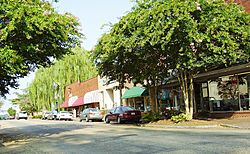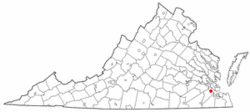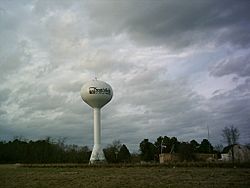Smithfield, Virginia facts for kids
Quick facts for kids
Smithfield, Virginia
|
||
|---|---|---|

Main Street, Smithfield
|
||
|
||
| Nickname(s):
The Ham Capital of the World
|
||

Location in the Commonwealth of Virginia
|
||
| Country | United States | |
| State | Virginia | |
| County | Isle of Wight | |
| Incorporated (town) | 1752 | |
| Area | ||
| • Total | 10.65 sq mi (27.58 km2) | |
| • Land | 9.72 sq mi (25.19 km2) | |
| • Water | 0.92 sq mi (2.39 km2) | |
| Elevation | 30 ft (9 m) | |
| Population
(2020)
|
||
| • Total | 8,533 | |
| • Estimate
(2022)
|
8,867 | |
| • Density | 871.47/sq mi (336.47/km2) | |
| Time zone | UTC-5 (EST) | |
| • Summer (DST) | UTC-4 (EDT) | |
| ZIP codes |
23430-23431
|
|
| Area code(s) | 757, 948 | |
| FIPS code | 51-73200 | |
| GNIS feature ID | 1474779 | |
| Website | www.smithfieldva.gov | |
Smithfield is a town in Isle of Wight County, Virginia, in the United States. It's part of the Hampton Roads area. In 2020, about 8,533 people lived there.
Smithfield is super famous for its delicious hams, called "Smithfield hams." In 1926, a law was even made saying that a true Smithfield ham *must* be made right in the town! Smithfield Foods is a huge company based here. It's the world's largest pork processor. This company raises millions of pigs and processes tons of pork every year.
Contents
History of Smithfield
The area where Smithfield is now was first settled in 1634. It's located on the Pagan River, south of Jamestown. Native Americans called this area Warascoyak, which means "point of land."
In 1634, the Virginia colony officially named the area Warrosquyoake Shire. But it was already known as "Warascoyack County" before that. In 1637, its name was changed to Isle of Wight County.
In 1730, a law called the Tobacco Inspection Act of 1730 made "Warricksqueak Bay" a place where tobacco had to be officially checked.
Founding the Town
The town of Smithfield was started as a seaport in 1752. It was founded by a person named Arthur Smith IV. A surveyor named Jordan Thomas mapped out the town for Captain Arthur Smith in 1750.
Because Smithfield was a river town, its growth depended on the river. The "Wharf Hill" area by the water was where many of Smithfield's businesses began. These businesses eventually included growing peanuts and raising pigs. This led to the town being called the "Peanut Capital of the World" and later the "Ham Capital of the World."
Ham and Peanut Industries
In 1763, George Purdie bought some land in Smithfield. His neighbor, Captain Mallory Todd, started the business of curing and shipping hams. This made Smithfield hams famous all over the world.
The peanut industry in Smithfield continued until a big fire in 1921. This fire destroyed the peanut warehouses. After the fire, the peanut trade moved to Suffolk, Virginia, which had a railroad hub.
Smithfield During Wars
Smithfield was important during both the American Revolutionary War and the American Civil War. This was because it was close to the James River. During the Revolutionary War, patriots used Wharf Hill to get weapons and supplies safely. They also used it to direct cannon fire on Main Street.
Historic Buildings and Preservation
The Mansion on Main was a beautiful home owned by Richard Samuel "R.S." Thomas. He helped save the St. Luke's Church, which was built in 1632. This church is now a National Historic Landmark. Thomas even wrote a book about the church to prove it was built in 1632.
He wrote: "I want to prove that this Church was built in 1632. I will prove it by showing that people were very religious back then, by old stories, by old records, and by the church's own bricks and mortar."
Today, Smithfield is about 10.1 square miles (26.1 km2) in size. The company that makes the famous ham was bought by a Chinese company in 2014.
Geography of Smithfield
Smithfield is located at 36°58′44″N 76°37′7″W / 36.97889°N 76.61861°W.
The town has a total area of about 10.4 square miles (27.1 km2). Most of this area, about 9.5 square miles (24.7 km2), is land. The rest, about 0.9 square miles (2.4 km2), is water.
Population and People
| Historical population | |||
|---|---|---|---|
| Census | Pop. | %± | |
| 1850 | 733 | — | |
| 1860 | 777 | 6.0% | |
| 1870 | 652 | −16.1% | |
| 1880 | 814 | 24.8% | |
| 1890 | 891 | 9.5% | |
| 1900 | 1,225 | 37.5% | |
| 1910 | 1,278 | 4.3% | |
| 1920 | 1,181 | −7.6% | |
| 1930 | 1,179 | −0.2% | |
| 1940 | 1,178 | −0.1% | |
| 1950 | 1,180 | 0.2% | |
| 1960 | 917 | −22.3% | |
| 1970 | 2,713 | 195.9% | |
| 1980 | 3,718 | 37.0% | |
| 1990 | 4,686 | 26.0% | |
| 2000 | 6,324 | 35.0% | |
| 2010 | 8,089 | 27.9% | |
| 2020 | 8,533 | 5.5% | |
| 2022 (est.) | 8,867 | 9.6% | |
| U.S. Decennial Census | |||
In 2010, there were 8,089 people living in Smithfield. There were 2,438 households, and 1,830 families. The town had about 851.5 people per square mile.
Most people in Smithfield were White (67.22%). About 30.87% were African American. A small number of people were Native American, Asian, or from other backgrounds. About 0.93% of the population was Hispanic or Latino.
In 2000, about 37.1% of households had children under 18. About 53.2% were married couples. The average household had 2.55 people. The average family had 2.95 people.
The median age in Smithfield was 38 years old. About 27.0% of the population was under 18. About 13.6% were 65 or older.
The median income for a household in the town was $43,224. For a family, it was $53,906. About 12.0% of the population lived below the poverty line.
Culture and Attractions
Smithfield is known as the "ham capital of the world" and attracts many visitors. The Historic District is a big draw. It has over 70 old buildings from the Colonial, Federal, and Victorian times.
Historic Sites to Visit
Some historic buildings that tourists love to see include:
- The Isle of Wight County Museum
- Historic Fort Huger
- The Schoolhouse Museum
- The Old Courthouse of 1750
- St. Luke's Church, a National Historic Landmark just outside downtown.
Other interesting old places are the Smithfield Inn, the Wentworth-Grinnan House, and Windsor Castle Park.
Just outside Smithfield, you can visit:
- Boykin's Tavern Museum
- The 1800 Isle of Wight Courthouse
- Darden's Country Store & Smokehouse
The Jamestown/Scotland Ferry lets visitors easily travel to Williamsburg, Virginia. This connects Smithfield to the historic triangle area. Smithfield is a great place for a day trip from cities like Norfolk and Richmond.
Places on the National Register
Several places in Smithfield are listed on the National Register of Historic Places. This means they are important historic sites. Some of these include:
- The Fort Boykin Archaeological Site
- Four Square
- The P. D. Gwaltney Jr. House
- Ivy Hill Cemetery
- Poplar Hill
Fun Events and Activities
Smithfield has many events throughout the year. Family-friendly events include the Christmas Parade, the Smithfield Farmers Market, and Smithfield Olden Days. Local businesses and restaurants also offer fun things to do. The Smithfield Little Theater puts on plays all year.
For outdoor fun, you can visit Windsor Castle Park, Nike Park, and Cypress Creek Golf Course. People enjoy boating, fishing, hunting, and biking. The town also has a skate park, trails, and campgrounds.
Gallery
Schools in Smithfield
- Carrollton Elementary School (Pre-Kindergarten to 3rd grade)
- Hardy Elementary School (Pre-Kindergarten to 4th grade)
- Westside Elementary School (4th to 6th grade)
- Smithfield Middle School (7th to 8th grade)
- Smithfield High School (9th to 12th grade)
Notable People from Smithfield
- William K. Barlow (1936–2022) – A politician from Virginia.
- Mary Batten (born 1937) – A writer who focuses on science topics.
- Lewis C. Bidamon (1806–1891) – A leader in the Illinois militia.
- Brian Blount – A Presbyterian minister and scholar.
- Robert Butler (1784–1853) – A state politician in Virginia.
- Cynthia Clarey (born 1949) – An opera singer and teacher.
- Cliff Daniels (born 1988) – A crew chief in NASCAR.
- Ernest A. Finney Jr. (1931–2017) – A Chief Justice of South Carolina.
- Joseph W. Luter III (born 1939) – The chairman of Smithfield Foods.
- Otelia B. Mahone (1835–1911) – A nurse during the American Civil War.
- Parke S. Rouse Jr. (1915–1995) – A journalist, writer, and historian.
- Arthur Smith (1785–1853) – A U.S. Representative for Virginia.
- Arthur Smith IV (1680–1755) – A landowner and politician who helped start Smithfield.
- Allie Edward Stakes Stephens (1900–1973) – A Lieutenant Governor of Virginia.
- Chris Taliaferro (born 1965) – A member of the Chicago City Council.
See also
 In Spanish: Smithfield (Virginia) para niños
In Spanish: Smithfield (Virginia) para niños















